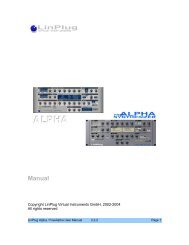User Guide - LinPlug Virtual Instruments
User Guide - LinPlug Virtual Instruments
User Guide - LinPlug Virtual Instruments
Create successful ePaper yourself
Turn your PDF publications into a flip-book with our unique Google optimized e-Paper software.
The Drawbar SectionThe Drawbar section is the most important part of daOrgan, as this is where theinstrument's overall sound is determined. The Drawbar section is located in the uppermiddle of the user interface.One of the reasons why the original Hammond B-3 became popular, and remains so tothis day, was because of its versatility. And just like its predecessor, <strong>LinPlug</strong>'s daOrgancan sound like a wide range of instruments and ensembles ranging from a carnival, a hornsection and a big band, to a small jazz combo, a funk group, a percussion section or aflute. How can all these different sounds be created with one instrument? The answer liesin the drawbars.daOrgan's nine drawbars (Section B) are used to set the level of the nine harmonics thatmake up the instrument's sound. Moving from left to right these harmonics are: the suboctave(16"), the fifth (5 1/3"), the fundamental (8"), the 8th (4"), the 12th (2 2/3"), the 15th(2"), the 17th (1 3/5"), the 19th (1 1/3"), and the 22nd (1"). All of these except the 17th areeither roots or fifths. The 17th is a third. Each drawbar's color indicates its relationship tothe fundamental pitch. The white and brown drawbars are called the consonants andcomprise all the roots and the lower fifths. The black drawbars are called the dissonantsand consist of the higher fifths and the third. Using this set of harmonics, a wide range ofsounds can be created.Each drawbar has eight continuously-variable degrees to which it can be "drawn" or pulledout. A setting of eight is the loudest, while all the way in silences the drawbar. Thus, eachdrawbar or "stop" can be "voiced" or individually altered, even while the instrument isbeing played.On its own, the fundamental drawbar generates a sine wave, thus producing a pure fluteliketone. Adding odd harmonics creates a square wave, producing a more clarinet-liketone. The odd harmonics "squared" generate a triangle wave, thus producing a string-like<strong>LinPlug</strong> daOrgan <strong>User</strong> <strong>Guide</strong> 10












